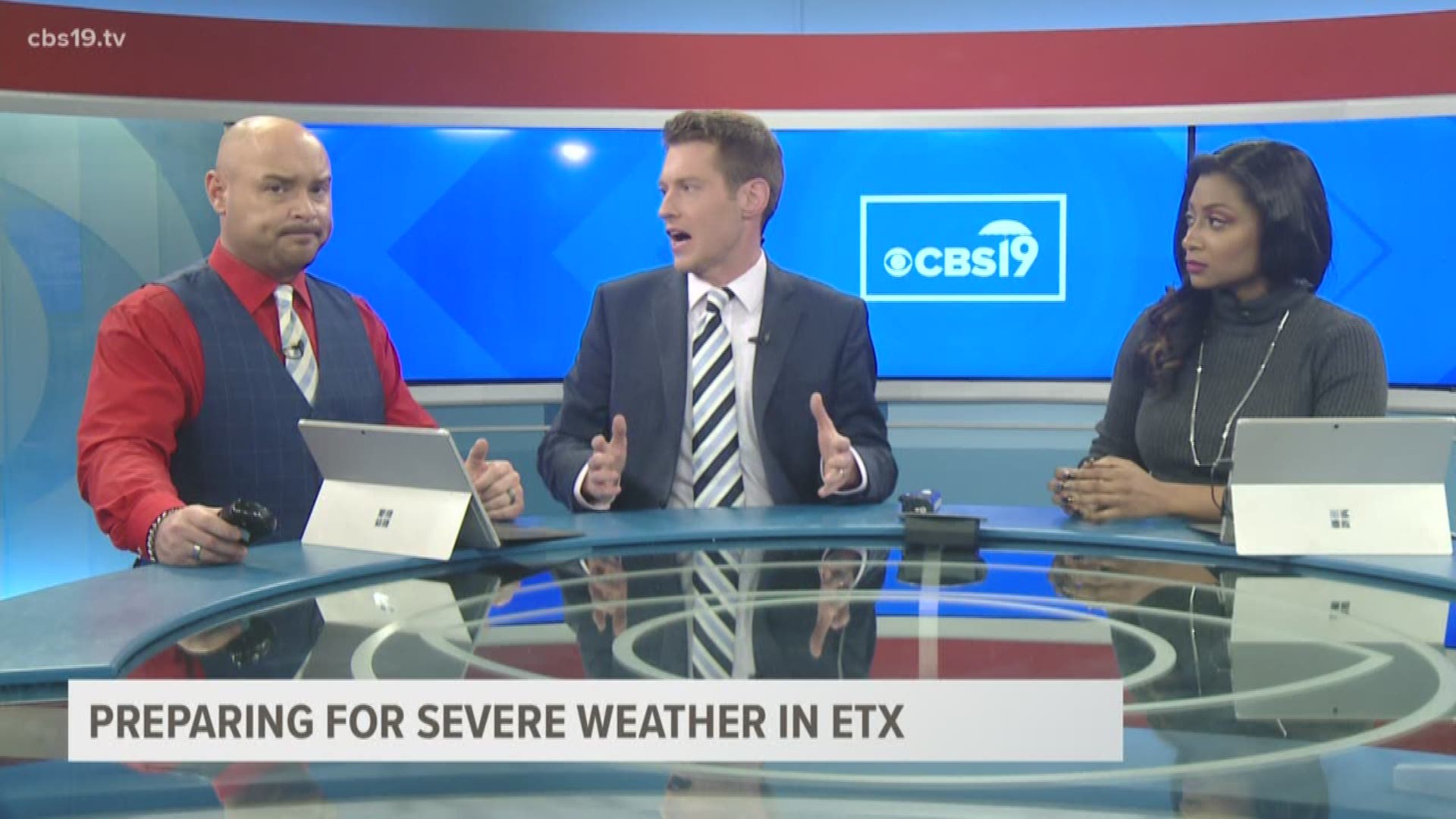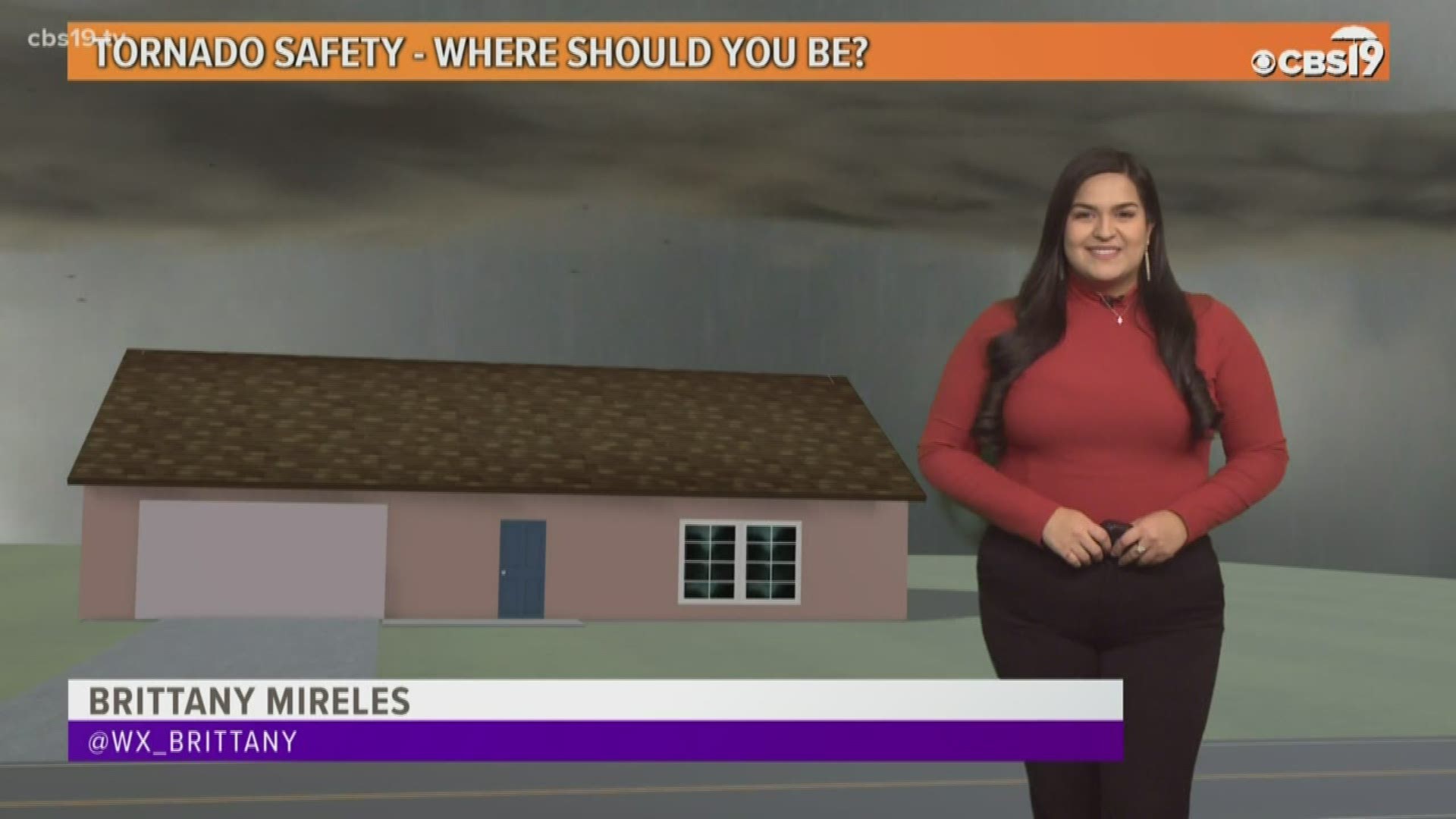TYLER, Texas — **EDITORS NOTE: The above video explaining what to do in the event of a tornado is from January 2020.
Knowing what to do when you see a tornado or when you hear a tornado warning can help protect you and your family.
During a tornado, people face hazards from extremely high winds and risk being struck by flying and falling objects.
After a tornado, the wreckage left behind poses additional injury risks. Although nothing can be done to prevent tornadoes, there are actions you can take for your health and safety.
To stay safe during a tornado, prepare a plan and an emergency kit, stay aware of weather conditions during thunderstorms, know the best places to shelter both indoors and outdoors, and always protect your head.
Tornadoes continue to impact locations across the country every year, bringing massive winds and destruction in their paths.
The 2016 tornado season claimed the lives of 18 individuals and injured another 325. Seventy-eight percent of those victims were in a mobile home or trailer park at the time of the tornado. These storms caused an estimated $183 million in property damage.
According to the National Oceanic and Atmospheric Agency (NOAA) there is no guaranteed safety during a tornado. Even the possibility of a tornado must be taken seriously. Although the most violent tornadoes can level and blow away almost any house and those within it, extremely violent EF5 tornadoes are very rare. Most tornadoes are much weaker. You can survive a tornado if you follow safety precautions.
Below are important tips to help keep you safe.
TIP 1: BE PREPARED
The best way to stay safe during a tornado is to be prepared with:
- Fresh batteries and a battery-operated TV, radio, or internet-enabled device to listen to the latest emergency weather information
- A tornado emergency plan including access to a “safe shelter” for yourself and for people with special needs
- An emergency kit (including water, non-perishable food, and medication)
- A list of important information, including telephone numbers
Be sure your children know what a tornado is, what tornado watches and warnings are, what county or parish they live in (warnings are issued by county or parish), and what makes a location a “safe shelter,” whether at home or at school.

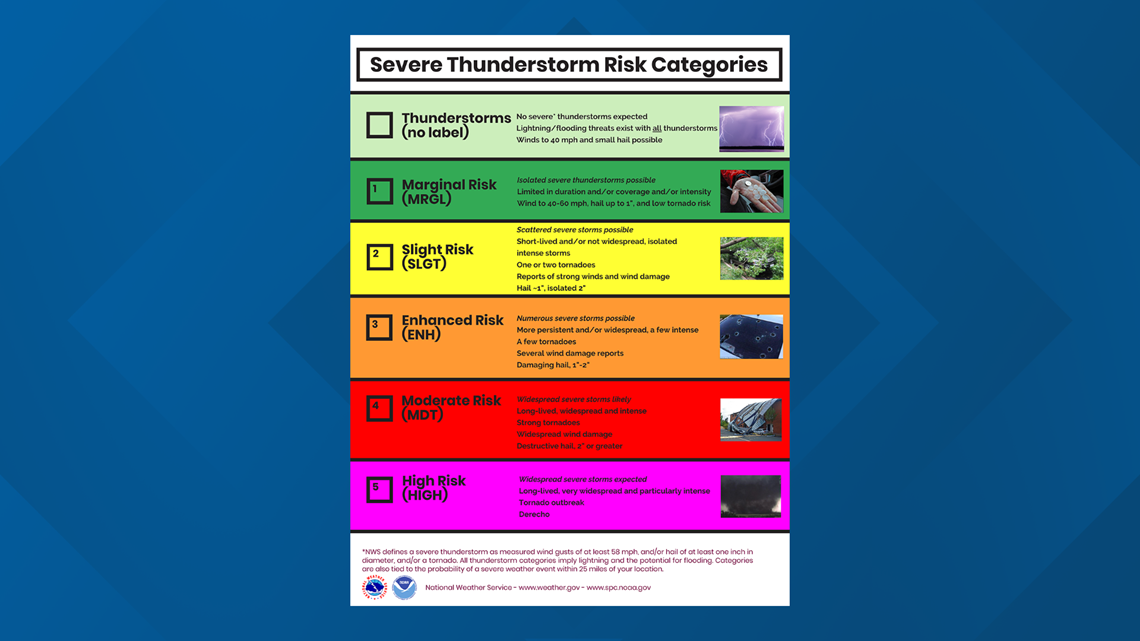
TIP 2: STAY AWARE OF WEATHER CONDITIONS
To protect yourself and your family from harm during a tornado, pay close attention to changing weather conditions in your area. If you know thunderstorms are expected, stay tuned to local radio and TV stations or an NOAA weather radio for further weather information. Some tornadoes strike rapidly without time for a tornado warning. The following weather signs may mean that a tornado is approaching:
- A dark or green-colored sky
- A large, dark, low-lying cloud
- Large hail
- A loud roar that sounds like a freight train
If you notice any of these conditions, take cover immediately, and keep tuned to local radio and TV stations or to a NOAA weather radio or check the internet.


TIP 3: KNOW WHERE TO SEEK SHELTER
Falling and flying debris cause most deaths and injuries during a tornado. Although there is no completely safe place during a tornado, some locations are much safer than others.
The most important things to remember are:
- GET IN - If you are outside, get inside. If you're already inside, get as far into the middle of the building as possible.
- GET DOWN - Get underground if possible. If you cannot, go to the lowest floor possible.
- COVER UP - Flying and falling debris are a storm's number one killer. Use pillows, blankets, coats, helmets, etc to cover up and protect your head and body from flying debris.
IF YOU'RE IN A HOME
Again, the key to tornado survival is a safety plan. Your plan at home should be known by everyone in the home and practiced at least twice each year. Children who may be at home alone should know what to do and where to go even if no adults are there.
Your selection of a tornado shelter in your home will depend on many factors. Use the basic guidelines and the information below to find your tornado safety area.
When selecting your shelter area, remember that your goals should be:
- Get as low as possible - completely underground is best.
- Put as many barriers between you and the outside as possible.
It is not the wind inside and around a tornado that kills and injures people - it's the flying debris that's in the wind. Items can fly through the air (broken glass, etc) or fall down (could range from small objects to objects the size and weight of cars)
Being completely underground is the best place to be in a tornado. If you have an underground storm cellar, use it. Make sure the door is securely fastened.
If the entrance to your storm cellar is outside, you should allow plenty of time to get to the shelter before the storm arrives. If you wait until the storm is upon you, you may be exposed to wind, hail, rain, lightning and maybe even flying debris as you go to the cellar.
A basement is also a good shelter in most cases. If your basement is not totally underground, or has outside doors or windows, stay as far away from them as possible. Items from above could fall into the basement, so it's a good idea to get under a stairwell or a piece of sturdy furniture. If possible, avoid seeking shelter underneath heavy objects on the floor above. Use coverings (pillows, blankets, sleeping bags, coats, etc) and helmets to shield your head and body and to protect yourself from flying debris.
A reinforced safe room (or above-ground tornado shelter) is as good as an underground shelter in most situations. Safe rooms are specially-designed reinforced tornado shelters built into homes, schools and other buildings. The Federal Emergency Management Agency, in close cooperation with experts in wind engineering and tornado damage, has developed detailed guidelines for constructing a safe room. For more information, go to the FEMA Saferoom website.
If you're like most people, you don't have an underground shelter.
In this case, you need to find a location that is:
- As close to the ground as possible
- As far inside the building as possible
- Away from doors, windows and outside walls
- In as small a room as possible
If you don't have a safe room, basement or underground storm shelter, what should you do? Remembering the basics of tornado safety, you should look around your home to determine the best place.
Bathrooms may be a good shelter, provided they are not along an outside wall and have no windows. Contrary to popular belief, there is nothing magically safe about getting in a bathtub with a mattress. In some cases, this might be a great shelter. However, it depends on where your bathroom is. If your bathroom has windows and is along an outside wall, it's probably not the best shelter.
Bathrooms have proven to be adequate tornado shelters in many cases for a couple of reasons. First, bathrooms are typically small rooms with no windows in the middle of a building. Secondly, it is thought that the plumbing within the walls of a bathroom helps to add some structural strength to the room.
However, with tornadoes there are no absolutes, and you should look closely at your home when determining your shelter area.
A small interior closet might be a shelter. Again, the closet should be as deep inside the building as possible, with no outside walls, doors or windows. Be sure to close the door and cover up.
If a hallway is your shelter area, be sure to shut all doors. Again, the goal is to create as many barriers as possible between you and the flying debris in and near a tornado. To be an effective shelter, a hallway should as be far inside the building as possible and should not have any openings to the outside (windows and doors).
The space underneath a stairwell could also be used as a shelter.
Generally speaking, you should not leave your home in your vehicle when a tornado threatens. In most cases, you will have a better chance of surviving by staying put in your home. Every home is different - there is no absolute safe place in every home. Use the guidelines. Unless you are deep underground, there is no such thing as a 100% tornado-proof shelter. Freak accidents can happen.

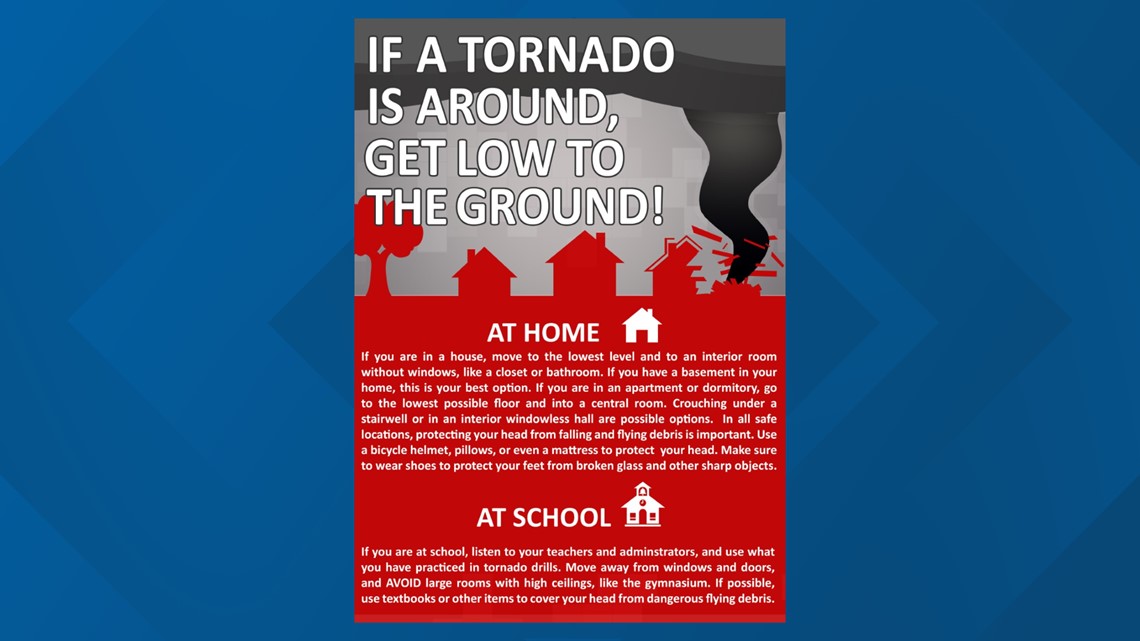
IF YOU'RE IN AN APARTMENT
The basic tornado safety guidelines apply if you live in an apartment. Get to the lowest floor, with as many walls between you and the outside as possible.
Apartment dwellers should have a plan, particularly if you live on the upper floors. If your complex does not have a reinforced shelter, you should make arrangements to get to an apartment on the lowest floor possible.
In some cases, the apartment clubhouse or laundry room may be used as a shelter, provided the basic safety guidelines are followed. You need to have a shelter area that's accessible at all times of the day or night.


IF YOU'RE IN A MOBILE HOME
Even an EF1 tornado, typically considered a "weak tornado", will most likely severely damage a mobile home and/or roll it over. This is why tornado safety plans are so crucial for residents of mobile homes!
Mobile homes are especially susceptible to high winds from severe thunderstorms and tornadoes. You will likely not be safe in a mobile home, whether you’re in a hallway, a closet or a bathroom. Mobile homes cannot stand up to even a weak tornado, and you should make plans BEFORE the storm arrives to get to a safe shelter. Due to the potentially short amount of time between a warning and the arrival of a tornado, people should consider executing their safety plans when a tornado watch is issued - do not wait for the tornado warning.
Taking cover under sturdy furniture, in a bathtub or closet or under a mattress will be meaningless in a mobile home if the home itself is destroyed, blown over, or rolled over by tornado or severe thunderstorm winds. Get out of mobile homes and find a more substantial shelter as quickly as possible.
Again, you need to have access to a shelter that is available at any time of the day or night.


IF YOU'RE OUT IN PUBLIC
A detailed home tornado safety plan won't help you much if you're away from home when the tornado threatens. You need to think about what you will do if a tornado threatens you while you're away from home - at work, church, school, while shopping, dining out, on vacation or participating in outdoor activities.
Danger is higher when you're away from home, when you may be unfamiliar with the area and away from your usual sources of weather information. It is important for business owners, and those responsible for safety in all types of public buildings and venues to think about and plan for tornado safety for all employees, occupants and potential visitors.
There is a myth that tornadoes don't hit urban areas, but this is false. Even if you are away from home in a large city, you should stay alert when severe weather threatens. More information can be found at the bottom of this page.

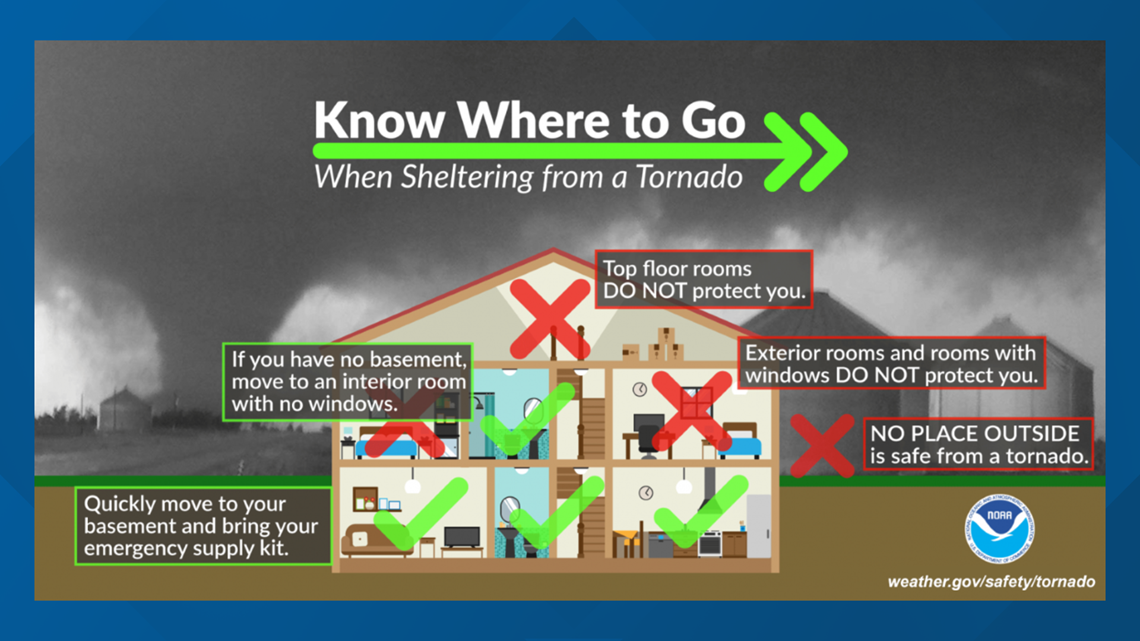
IF YOU'RE IN A HOTEL OR MOTEL
Think about tornado safety in hotels, motels. Some lodging establishments have safety plans for guests, but others may not, and you may be on your own. Some establishments suggest guests seek shelter in hallways. However, you should remember to avoid open hallways - hallways that have doors and/or windows on either end. These can become wind tunnels and send debris flying down the corridor. Interior bathrooms and closets near the center of the building may be good shelters in this situation. Again, wherever you are forced to seek shelter in a tornado, cover up with pillows, heavy blankets or whatever you can find.
IF YOU'RE IN A PUBLIC BUILDING
The same basic tornado safety guidelines apply in any public building, whether it's your local shopping mall, a hospital or nursing home, a grocery or discount store, a church, a hotel, convenience store, truck stop or restaurant.
If a tornado threatens, you should not leave in your car. Being in a sturdy building is most likely safer than being in your vehicle on the road if a tornado hits. Stay calm and cool and try to find a safe shelter wherever you are.
IF YOU'RE AT AN OUTDOOR EVENT
Being exposed outdoors is one of the worst places to be in a tornado or severe thunderstorm. Being involved in outdoor activities can sometimes put you at increased risk, because you're exposed outdoors and possibly in an unfamiliar area.
Organized outdoor events, including sporting events at all times of year, should have weather safety plans. People at large sporting events are especially vulnerable because of the difficulties involved in moving large numbers of people. Event coordinators or managers should have a detailed severe weather safety plan in place and practice it. People at large outdoor gatherings or events should listen when severe weather information is conveyed and follow instructions if a safety plan is put into action.
IF YOU'RE IN A VEHICLE
Vehicles - cars, trucks, sport utility vehicles, RVs, 18-wheelers, boats, trains, planes, etc. - are terrible places to be when a severe thunderstorm threatens. Fortunately, these situations can be avoided most of the time by being alert to the possibility of severe storms and tornadoes.
All types of vehicles can be blown over, rolled, crushed, lifted or otherwise destroyed by even a weak tornado. People have been hurt or killed when large trees crushed their cars.
Below are some safety tips:
- Consider delaying your trip if severe thunderstorms are in the area or along your path of travel.
- Monitor television, radio, NOAA weather radio, and the internet for storm location information.
- Be familiar with the area where you're traveling. Keep a highway map handy, one that includes the county names and boundaries. NWS severe weather warnings are issued based on counties. If you do not know what county you're in you could miss life-saving information
- If you're in your car, find a station broadcasting weather information. Some radio stations will interrupt programming to broadcast warnings and other information. Others are automated stations and may not. Search for a station with local weather information and listen for details. A battery operated weather radio is essential for travelers. Remember you will not get any warnings if you are listening to CD's or satellite radio in your vehicle.
- The chances of being hit directly by a tornado in your car are very small. However, severe thunderstorms contain other deadly and destructive elements that can threaten your life in your car, such as hail, wind, heavy rain and flooding.
Every situation is different, and if faced with a tornado threat while on the road, your best course of action will depend on your exact location, the tornado's location, speed, and direction of movement, road options available to you, nearby structures, time of day, traffic and weather conditions you're experiencing.
If the tornado is far enough away and road options and traffic allow, you should try to find a substantial building for shelter. Follow the basic tornado safety guidelines (get in - get down - cover up). Motorists have found truck stops, convenience stores, restaurants and other businesses to be adequate shelters in a tornado situation. Walk-in coolers can sometimes make a good shelter.
While you should never try to outrun a tornado in your vehicle, you may, in some situations, be able to get out of the tornado's way by driving out of its path, or simply stopping and allowing the tornado to pass. Again, this can be extremely dangerous unless traffic, time of day and road options allow you to see the tornado, determine which way it's moving (and how fast), find a road option that will take you out of its path (while avoiding other storms) and to safe shelter.
The worst-case scenario for motorists would be to be trapped in your vehicle on the road with no escape possible. This scenario could occur in more densely populated areas, in metropolitan areas at rush-hour or in high traffic situations, or on limited access roadways, such as interstates or turnpikes, where it might not be possible to quickly exit and find safe shelter. It is in these situations when it may become necessary to leave your vehicle and seek shelter in a ditch, culvert or low spot.
Highway overpasses are not tornado shelters, and these should be avoided.

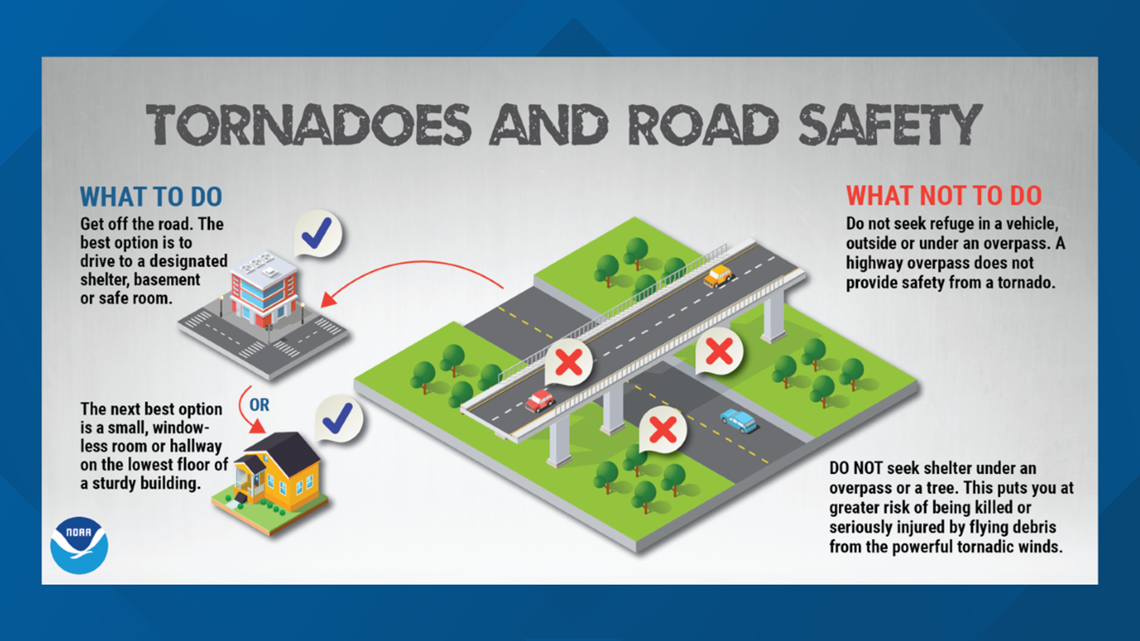
TAKING SHELTER OUTDOORS
Ditches, culverts and ravines should be used only as an absolute last resort. You will be exposed to flying debris, rain and hail, lightning and extreme wind. People have survived by seeking shelter in ditches, but people have also died. If you must leave your vehicle to seek shelter in a ditch, you should try to get as far away from the vehicle, as well as any other potential "missiles" as possible.
AFTER A TORNADO OCCURS
- STAY INFORMED: Continue to listen to local news or a NOAA Weather Radio to stay updated about tornado watches and warnings. Multiple rounds of thunderstorms capable of producing tornadoes are possible during severe weather outbreaks.
- CONTACT YOUR FAMILY AND LOVED ONES: Let your family and close friends know that you're okay so they can help spread the word. Text messages or social media are more reliable forms of communication than phone calls.
- ASSESS THE DAMAGE: After the threat for tornadoes has ended, check to see if your property has been damaged. When walking through storm damage, wear long pants, a long-sleeved shirt, and sturdy shoes. Contact local authorities if you see power lines down. Stay out of damaged buildings. Be aware of insurance scammers if your property has been damaged.
- HELP YOUR NEIGHBOR: If you come across people that are injured and you are properly trained, provide first aid to victims if needed until emergency response teams arrive.
Learn more about how to stay safe during a tornado.
Stay weather aware with the CBS19 mobile app.
- Click here to download the iPhone app.
- Click here to download the iPad app.
- Click here to download the Android app.
Stick with CBS19 everywhere you go. And don't worry, we've got you covered!

